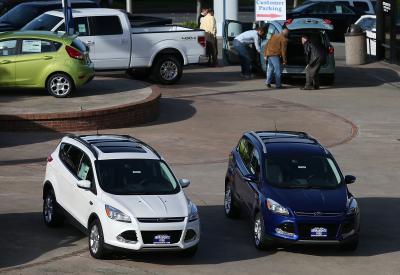
One brake on your Ford Escape is not releasing properly, causing noise, overheating of the brake and difficult driving. The problem is a sticking brake caliper. Replacement of both calipers on that axle may be required unless the sticking caliper can be repaired. Repair or replacement of a stuck caliper is a task that will require some physical effort, but is well within the abilities of the average home handyman.
The most common reasons for a stuck caliper are high friction in the caliper slides and brake pads that are completely worn out. The latter problem is repaired with a set of new brake pads and rotors, but even sticking slides are often repairable.
Jack the Escape up until the tire is off the ground and support the vehicle on jack stands. Make certain it is well supported because you will be working under the fender to do this task. Remove the tire and set aside for now.
The brake caliper is held on by two bolts. These bolts are located at the top and bottom of the caliper. Before removing the bolts try to pry the caliper back toward the center of the car to relax the clamping action on the brake pads. Even a slight amount of movement will make removal of the caliper much easier. After removing the bolts lift the caliper away from the rotor. Tie the caliper out of the way and in such a manner that it does not hang from the rubber hose. This process is the same for front and rear calipers.
In each of the mounting bolt holes is a removable metal tube. These are the caliper slides. Push back the rubber boots and force the the slides out of their holes. Removing the caliper support from the vehicle is often necessary to remove the slides if they are stuck. Clamp the caliper support securely in a vise and pull on the slide with pliers or vise grips. Some penetrating oil may help with the process. If you cannot remove them the caliper must be replaced. Replacement in pairs is strongly recommended. Once the slides are removed from their bores clean any old grease and rust from them using fine sandpaper or a wire brush in a grinder. Also clean the inside of the bore in the caliper. A drill bit held in your hand and slowly twisted works quite well for this. Coat the cleaned-up slide liberally with silicone grease and install in the bores. Install the rubber boots in the groove in the slides.The slides must be easily moved back and forth in the bores.
Using a large C-clamp push the caliper piston back completely. This is easy to do if you place an old brake pad against the piston and clamp between it and the back of the caliper. Tighten the C-clamp until the piston is fully compressed in the caliper. Install new brake pads and the caliper and tighten the caliper mounting bolts securely.
Put the tires back on and tighten the lugs securely. Press down on the brake pedal several times before attempting to drive the vehicle. Not doing this might result in an accident as the pads need to be seated against the rotor for the brake to work properly.